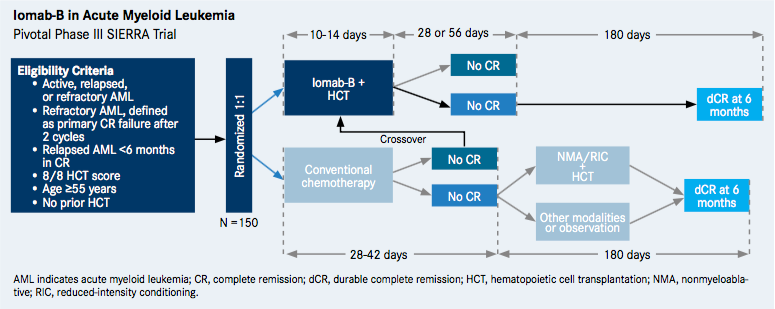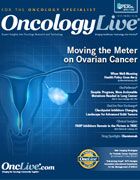Publication
Article
Novel Agent Aims to Improve HCT Outcomes in High-Risk AML
Author(s):
A clinical trial that utilizes a novel radiolabeled antibody–drug conjugate to pretreat older patients with relapsed or refractory acute myeloid leukemia as part of a stem cell transplantation regimen is aimed at creating improved outcomes for a high-risk population with limited therapeutic alternatives.
John Pagel, MD, PhD

John Pagel, MD, PhD
A clinical trial that utilizes a novel radiolabeled antibody—drug conjugate to pretreat older patients with relapsed or refractory acute myeloid leukemia (AML) as part of a stem cell transplantation regimen is aimed at creating improved outcomes for a high-risk population with limited therapeutic alternatives, according to a key investigator.
The phase III SIERRA trial (NCT02665065) will randomize patients age 55 years and older to Iomab-B or conventional chemotherapy as a preconditioning regimen before allogeneic hematopoietic cell transplantation (HCT). The primary endpoint is durable complete remission by bone marrow assessment at 6 months.
“This is an incredibly important trial because there is such a large unmet need,” said John Pagel, MD, PhD, chief of the Hematologic Malignancies Program at the Swedish Cancer Institute in Seattle, in an interview. “The trial is seeking to provide a long-term survival benefit for patients who have limited other options for significant survival.”
“We want to deliver as much radioiodine as we safely can to sites of disease, including the bone marrow as well as to the spleen and the other hematolymphoid organs,” Pagel said. “Iomab-B will also wipe out the blood-forming elements, so we follow it, or rescue the bone marrow, with an allogeneic reduced-intensity stem cell transplant approach.”
Currently, clinicians who treat older patients with AML are limited in their ability to use the high-dose preconditioning myeloablative regimens that have proved effective in candidates for HCT primarily because of the risks of nonrelapse mortality and graft-versus-host disease, according to Pagel and colleagues.2
There are multiple approaches for using reduced-intensity regimens, such as the regimen employing udarabine (90 mg/kg) and 2 Gy total body irradiation developed for older patients at the Fred Hutchinson Cancer Research Center, but the success of these regimens has been hampered by high relapse rates among patients with significant persistent (ie, refractory) disease in the marrow when the preconditioning begins.2
The search for more effective therapies led Pagel, who was a member of the Fred Hutchinson research team, and other investigators to consider Iomab-B. “These older patients need more therapy to control their disease but you can only give them so much external beam radiation or chemotherapy,” Pagel said. “The idea was to come up with a way to deliver escalated doses of therapy directly to sites of disease and limit the amount of therapy that is going to normal organs, and thus reduce toxicities associated with a full myeloablative transplant approach.”
Iomab-B in Acute Myeloid Leukemia

Iomab-B, which utilizes a beta-emitting isotope that is widely employed in papillary thyroid cancer, can deliver radiation specifically to the hematopoietic tissues at significantly higher rates than its impact on the liver, lung, or kidney.3 It sends at least 2 to 3 times more radiation to the bone marrow, up to 12 times more to the spleen, and 2 to 8 times more to lymph nodes.2
The therapy has been very well tolerated, with manageable infusion-related reactions as the most frequent adverse event.2 “Most people have no side effects related to the Iomab-B and we don’t think it significantly increases the toxicity above that seen with a standard reduced-intensity transplant," said Pagel.
Patients receive a dosimetric dose on an outpatient basis, Pagel said in a presentation last year.3 The biodistribution is then analyzed and a patient-specific dose is calculated and delivered to the patient. Iomab-B, which is administrated intravenously, is a one-time treatment.
More than 300 patients have been treated with Iomab-B in early clinical studies, including many patients who are over the age of 65 years with refractory AML who have a very small chance of being alive at 2 years, Pagel said in the interview. “Almost everybody goes into a complete remission with Iomab-B,” Pagel said.
In phase I/II clinical trial results, 30% of patients >50 years with relapsed refractory AML who were given Iomab-B (N = 27) remained alive at 1 year compared with the typical 10% rate for individuals who received conventional HCT or chemotherapy.3 At 2 years, the majority of those patients were still alive as opposed to almost none of those who receive conventional therapy. Additionally, all patients were able to proceed to engraftment of allogeneic stem cells.
In the SIERRA trial, participants in the control arm who do not achieve a complete response by day 42 will have the option of crossing over to the Iomab-B arm, Pagel said. The trial is starting to enroll patients, according to a spokesman for Actinium Pharmaceuticals, which is sponsoring the study. Plans call for recruiting 150 participants.
References
- Iodine I 131 monoclonal antibody BC8. The NCI Drug Dictionary. National Cancer Institute website. www.cancer.gov/publications/dictionaries/cancer-drug?cdrid=43463. Accessed November 2, 2016.
- Pagel JM, Gooley TA, Rajendran J, et al. Allogeneic hematopoietic cell transplantation after conditioning with I—anti-CD45 antibody plus fludarabine and low-dose total body irradiation for elderly patients with advanced acute myeloid leukemia or high-risk myelodysplastic syndrome. Blood. 2009;114(27):5444-5453. doi: 10.1182/blood-2009-03-213298.
- John Pagel, MD, PhD discussing Iomab-B for HSCT (bone marrow transplant) in older patients with relapsed/refractory acute myeloid leukemia [video]. Actinium Pharmaceuticals Inc.ir.actiniumpharma.com/video-gallery/video/780/john-pagel-m-d-ph-d-discussing-iomab-b-for-hsct-bone. Accessed November 2, 2016.
Iomab-B consists of a monoclonal antibody labeled with iodine-131 that is targeted to destroy cells expressing CD45, a tyrosine phosphatase found on most myeloid and lymphoid leukemic cells.1 It is the first anti-CD45 agent in development, said Pagel.










